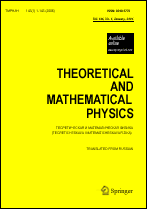|
This article is cited in 13 scientific papers (total in 13 papers)
Relaxation to Intermediate Attractors in Nonlinear Wave Equations
N. Szpak
Johann Wolfgang Goethe-Universität
Abstract:
We study the dynamics of nonlinear wave equations near the threshold of singularity formation, motivated by some unexpected features observed in the critical gravitational collapse. One of the features, the existence of a universal intermediate attractor in the dynamics at the threshold of singularity formation, is studied in more detail. The result is a scheme of the evolution: for all initial data sufficiently near the threshold, the solutions reach one universal static solution, which plays the role of an intermediate attractor. The solutions remain near the attractor for some time, which scales in a simple way with a parameter of the initial data, and then departs in one of two “opposite” directions, eventually forming a singularity or dispersing. The relaxation as well as the departure from the attractor is governed in the linear approximation by quasi-normal modes (QNMs) and one growing mode. Moreover, the profiles of the perturbation modes with their oscillation frequencies and damping or amplifying factors, calculated as eigenvalue problems (linear ODEs) have been observed in numerical evolution (nonlinear PDEs). In particular, the exponent of the growing mode determines the lifetime of the intermediate dynamics (near the attractor), and a few least damped QNMs have been observed as ringing in the relaxation process.
Citation:
N. Szpak, “Relaxation to Intermediate Attractors in Nonlinear Wave Equations”, TMF, 127:3 (2001), 475–487; Theoret. and Math. Phys., 127:3 (2001), 817–826
Linking options:
https://www.mathnet.ru/eng/tmf475https://doi.org/10.4213/tmf475 https://www.mathnet.ru/eng/tmf/v127/i3/p475
|


| Statistics & downloads: |
| Abstract page: | 316 | | Full-text PDF : | 188 | | References: | 55 | | First page: | 1 |
|




 Contact us:
Contact us: Terms of Use
Terms of Use
 Registration to the website
Registration to the website Logotypes
Logotypes








 Citation in format
Citation in format 
